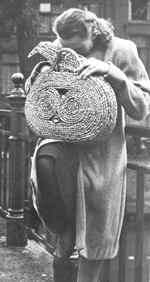The Dutch resistance movement came about because of two simple facts – outrage that their country had been invaded and sheer horror at what happened to the Dutch Jews. Holland had swiftly fallen as a result of the onslaught of Blitzkrieg in 1940. There were many in Nazi Germany, including Joseph Goebbels, who had hoped that many Dutch people would absorb National Socialism into their culture. In this they were wrong. The Dutch rallied around their exiled royal family and the Dutch resistance was to provide the Allies with valuable intelligence information.
 |
Any form of resistance in the Netherlands took time to evolve. This was primarily because the country was isolated from London and from the influence of the Special Operations Executive (SOE). This remained the case until 1944. The Germans had heavily defended the Dutch coastline. Any support from SOE that involved a sea landing – however covert – would have been difficult. Dutch airspace was also well defended by the Germans as Allied bombers frequently flew over the Dutch coast en route for Germany. The area was riddled with radar so the traditional way of getting SOE operatives into a country (by Lysander) was also fraught with problems.
Being a small country in terms of its geographic size made it easier for the Gestapo to enforce its authority. As early as March 1942, the Gestapo had arrested a wireless operator in Holland and had used his codes to send false messages to Britain encouraging the British to assist the Dutch resistance movement. Any agents and supplies dropped in Holland by the British were immediately intercepted by the Germans. This deception lasted until the autumn of 1943. Therefore, during this time the Dutch resistance was deprived of the expert help that SOE had been able to give others.
What provoked a major reaction in Holland was the wave of arrests of Jews. This the Dutch people could not tolerate. The first arrests were greeted with solidarity strikes by non-Jewish Dutch workers. In May 1943, there was another general strike in Holland when the Germans sent back to POW camps Dutch soldiers captured in the spring of 1940 but who were due for repatriation to Holland three years later. The Germans reacted to this strike with brutality, shooting 150 people. When a notorious Dutch collaborator, General Seyffardt, was assassinated by the Dutch, 250 hostages were also shot.
The Dutch resistance made its mark with the collection of intelligence that could be useful to the Allies. It was the Dutch resistance who informed the Allies of the fact that the SS IX and X divisions were in the region of Arnhem in September 1944 – information that was essentially ignored with disastrous consequences. The Dutch resistance also helped Dutch Jews to escape – especially children. Nine organisations were created to do this and they specialised in hiding people, forging identity papers etc. This, along with its intelligence work, proved to be its most important work as opposed to the classic image of resistance units blowing up bridges etc.